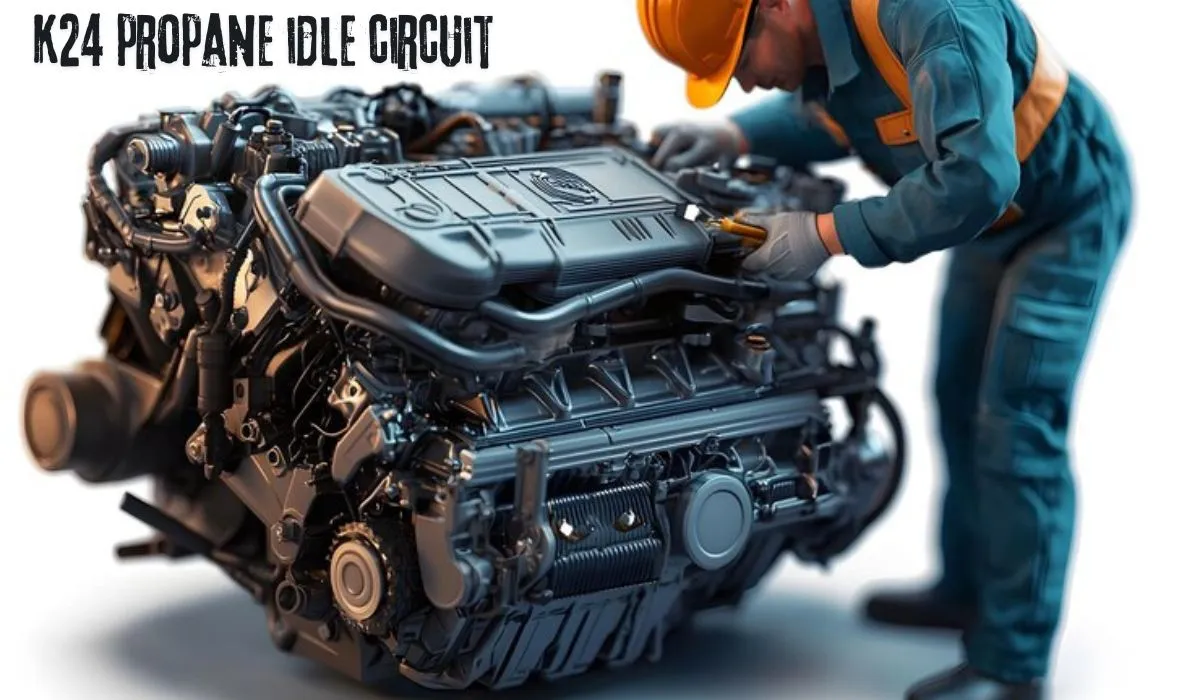The K24 propane engine, manufactured by Nissan, is widely known for its reliability and efficiency, especially in industrial applications such as forklifts and generators. One of the critical components that ensures the smooth operation of this engine is the idle circuit. The “K24 propane idle circuit” plays a vital role in controlling the engine’s idle speed, managing fuel delivery, and regulating air intake. In this article, we will explore the intricacies of the K24 propane idle circuit, its components, functions, and troubleshooting techniques. By the end of this article, you will have a thorough understanding of how this system works and how to maintain it for optimal engine performance.
What is the K24 Propane Engine?
Overview of the Nissan K24 Engine
The Nissan K24 engine is a 2.4-liter, inline-four-cylinder engine that has been adapted to run on propane. Propane, also known as liquefied petroleum gas (LPG), is a popular alternative fuel due to its clean-burning properties and cost-effectiveness. The K24 engine is widely used in industrial and commercial applications, where reliability, efficiency, and low emissions are crucial. It is particularly favored in forklifts, where it powers the vehicle with a consistent and smooth performance.
Importance of Propane as a Fuel Source
Propane is an environmentally friendly fuel that burns cleaner than gasoline or diesel, producing fewer greenhouse gases and harmful emissions. This makes propane-powered engines, such as the K24, an attractive option for industries looking to reduce their carbon footprint. Additionally, propane is readily available, and its use in engines can lead to lower operating costs due to its efficiency and affordability.
The Function of the K24 Propane Idle Circuit
What is an Idle Circuit?
An idle circuit in an engine is responsible for maintaining the engine’s idle speed, which is the speed at which the engine runs when it is not under load and the throttle is closed. This circuit ensures that the engine runs smoothly at low RPMs, preventing stalling and rough idling. In the context of the K24 propane engine, the idle circuit controls the flow of fuel and air into the engine during idle, ensuring that the engine operates efficiently and reliably.
How the K24 Propane Idle Circuit Works
The “K24 propane idle circuit” is a critical component of the engine’s fuel system. It regulates the amount of propane that enters the combustion chamber when the engine is idling. The circuit works by adjusting the air-fuel mixture to maintain the optimal stoichiometric ratio, which is the ideal ratio of air to fuel for complete combustion. This precise control of the air-fuel mixture is essential for ensuring that the engine idles smoothly and does not stall.
The idle circuit includes several components, such as the idle air control valve (IACV), the propane fuel regulator, and various sensors that monitor engine parameters. These components work together to regulate the engine’s idle speed and maintain a steady and smooth operation.
Key Components of the K24 Propane Idle Circuit
Idle Air Control Valve (IACV)
The idle air control valve (IACV) is one of the most important components of the K24 propane idle circuit. It controls the amount of air that bypasses the throttle plate when the engine is idling. By adjusting the airflow, the IACV helps to maintain the engine’s idle speed and prevent stalling.
In the K24 engine, the IACV is electronically controlled, allowing it to respond quickly to changes in engine load or operating conditions. When the engine is idling, the IACV adjusts the airflow to ensure that the engine runs smoothly, even when external factors such as temperature or altitude change.
Propane Fuel Regulator
The propane fuel regulator is responsible for maintaining the correct fuel pressure and delivering the right amount of propane to the engine. It reduces the high pressure of the propane in the tank to a level that is suitable for engine operation. The regulator also ensures that the fuel is vaporized before it enters the combustion chamber, which is essential for proper combustion and efficient engine performance.
In the K24 propane engine, the fuel regulator works in conjunction with the idle circuit to ensure that the correct amount of fuel is delivered during idle. This precise control of fuel delivery helps to maintain the optimal air-fuel mixture and ensures smooth engine operation.
Engine Control Unit (ECU)
The Engine Control Unit (ECU) is the brain of the K24 propane engine’s fuel system.It monitors various engine parameters, such as temperature, RPM, and load. Moreover, it uses this information to control the idle circuit effectively. Consequently, this comprehensive monitoring allows for precise adjustments and optimal engine performance. The ECU adjusts the idle air control valve and the fuel regulator to maintain the correct air-fuel mixture and idle speed.
The ECU in the K24 engine is programmed to optimize the engine’s performance under various operating conditions. It ensures that the idle circuit functions correctly and that the engine runs smoothly and efficiently, even in challenging environments.
You Might Also Like: Understanding the Delco 10464455 : A Comprehensive Guide
Common Issues with the K24 Propane Idle Circuit
Symptoms of Idle Circuit Problems
The “K24 propane idle circuit” is a critical system, and when it malfunctions, it can lead to several issues with the engine’s performance. Some common symptoms of idle circuit problems include:
- Rough Idling: The engine may run unevenly when idling, with fluctuations in RPMs that can cause the vehicle to shake or vibrate.
- Stalling: If the idle circuit is not functioning correctly, the engine may stall when idling, especially when coming to a stop or during idle conditions.
- High or Low Idle Speed: An incorrect idle speed, either too high or too low, can indicate a problem with the idle circuit. This can lead to poor engine performance and increased fuel consumption.
- Engine Hesitation: The engine may hesitate or stumble when accelerating from idle, which can be a sign of an issue with the air-fuel mixture controlled by the idle circuit.
Causes of Idle Circuit Malfunctions
Several factors can contribute to malfunctions in the K24 propane idle circuit. Understanding these causes can help in diagnosing and resolving issues effectively:
- Dirty or Faulty Idle Air Control Valve (IACV): Over time, the IACV can become clogged with carbon deposits or dirt, affecting its ability to regulate airflow. A faulty IACV may also fail to respond to commands from the ECU, leading to idle speed issues.
- Propane Fuel Regulator Problems: A malfunctioning fuel regulator can result in incorrect fuel pressure or improper vaporization of propane, leading to an imbalanced air-fuel mixture during idle.
- Sensor Failures: Sensors that monitor engine parameters, such as the throttle position sensor (TPS) or the manifold absolute pressure (MAP) sensor, can fail or provide incorrect readings. This can cause the ECU to improperly adjust the idle circuit.
- Vacuum Leaks: Vacuum leaks in the intake manifold or hoses can cause unmetered air to enter the engine, disrupting the air-fuel mixture and leading to rough idling or stalling.
Troubleshooting the K24 Propane Idle Circuit
Step-by-Step Diagnostic Process
Diagnosing issues with the K24 propane idle circuit requires a systematic approach. The following steps outline a general diagnostic process:
- Check for Vacuum Leaks: Start by inspecting the intake manifold, hoses, and connections for any signs of vacuum leaks. Use a smoke test or a spray bottle with soapy water to identify leaks that could be affecting the idle circuit.
- Inspect the Idle Air Control Valve (IACV): Remove the IACV and inspect it for signs of dirt, carbon buildup, or wear. Clean the valve using a suitable cleaner and reinstall it. If the IACV is faulty, replace it with a new one.
- Test the Propane Fuel Regulator: Check the fuel pressure and vaporization to ensure the regulator is working correctly. Repair or replace the regulator if it fails to maintain the correct pressure.
- Examine the Sensors: Use a diagnostic tool to check readings from sensors like the TPS and MAP. Replace any sensors that are providing incorrect readings.
- Check the ECU: Ensure that the ECU is functioning properly and that it is receiving accurate data from the sensors. Reprogram or replace the ECU if it does not respond correctly.
Preventative Maintenance Tips
To prevent issues with the “K24 propane idle circuit,” regular maintenance is essential. Here are some tips to keep the system running smoothly:
- Regular Cleaning of the IACV: Periodically clean the idle air control valve to prevent carbon buildup and ensure smooth operation.
- Inspect and Replace Hoses: Check all hoses connected to the intake manifold and fuel system for signs of wear or damage. Replace any that show signs of cracking or leakage.
- Maintain Fuel Regulator: Regularly inspect the propane fuel regulator for signs of wear or malfunction. Calibrate and ensure it functions efficiently.
- Sensor Calibration: Periodically check the calibration of sensors and replace any that are showing signs of wear or incorrect readings.
- ECU Updates: Keep the engine control unit updated with the latest software and programming to ensure optimal performance.
Enhancing the Performance of the K24 Propane Idle Circuit
Upgrading Components for Better Efficiency
Upgrading idle circuit components can boost K24 propane engine efficiency and smooth operation. Here are some potential upgrades:
- High-Performance IACV: Installing a high-performance idle air control valve can provide more precise airflow regulation, leading to improved idle stability.
- Advanced Fuel Regulators: Upgrading to an advanced propane fuel regulator improves fuel delivery and vaporization, balancing the air-fuel mixture.
- Aftermarket Sensors: High-quality aftermarket sensors offer more accurate readings, helping the ECU fine-tune the idle circuit.
Custom Tuning for Specific Applications
In some cases, custom tuning of the ECU can optimize the idle circuit for specific applications. This is particularly useful in industrial settings, where, in addition, the engine may operate under unique conditions or varying loads. Consequently, tailored adjustments become essential for maintaining optimal performance. By tuning the ECU, you can adjust the idle circuit parameters to achieve the best performance for your specific needs.
Conclusion
The K24 propane idle circuit is key to smooth engine operation. Understanding, diagnosing, and maintaining the K24 propane idle circuit is crucial for anyone working with this engine.
By following maintenance tips and considering upgrades, you can keep your engine running smoothly and reliably, even in tough conditions. Mastering the K24 propane idle circuit will help you maximize performance and minimize downtime.
In summary, the K24 propane idle circuit is a complex yet essential system that requires careful attention and maintenance. With the right knowledge and tools, you can maintain peak engine performance, ensuring Nissan’s reliability and quality.





4 thoughts on “Understanding the K24 Propane Idle Circuit : A Comprehensive Guide”